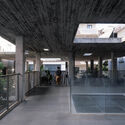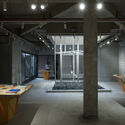
-
Architects: TAO - Trace Architecture Office
- Area: 680 m²
- Year: 2022
-
Photographs:Li HUA, ZC Architectural Photography Studio

"A Hamlet within the urban village" is TAO’s first urban renewal project in Nantou Ancient Town, Shenzhen. This is an urban cluster that originally consisted of multiple buildings with different property rights of the land. Part of it was preserved and partly demolished and renovated to form a new composite urban community. It is both a building and a miniature urban village. An open-ended concrete structure integrates all the old and new elements of the site, making it a stage for the lively and ever-changing life here.


























































